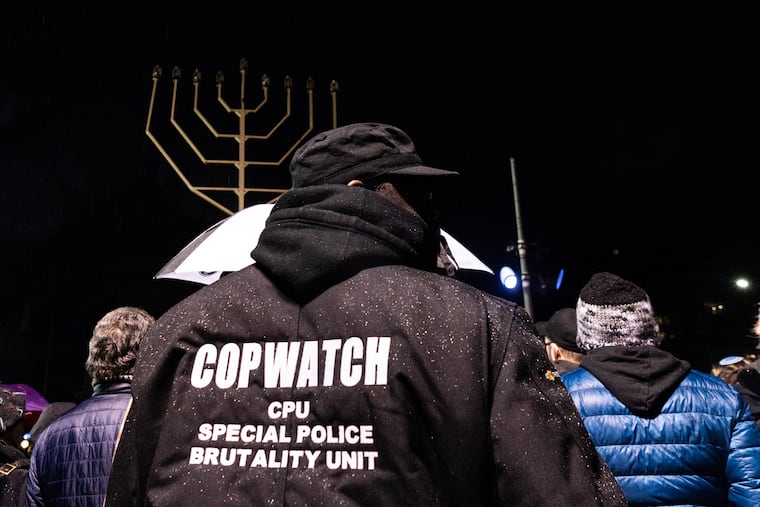Antiracist solidarity, not political exploitation, is the way to end the surge of anti-Semitic attacks | Opinion
Anti-Semitic attacks have long been exploited to promote injustice. Instead of making Jews safer, it produces more harm.

On the seventh night of Hanukkah, hours after the shabbat, an assailant entered the home of Rabbi Chaim Rottenberg in Monsey, N.Y., and stabbed five people. Five Jews. The stabbing was the 13th anti-Semitic attack in New York in the span of two weeks. Earlier last month, in Jersey City, N.J., two assailants opened fire in a kosher market and killed three people.
After the attack in Monsey I didn’t know how to feel. I don’t wear a yarmulke. I don’t go to synagogue or spend time in a rabbi’s house or in kosher supermarkets. The chances of my being victimized in an attack targeting Jews are very low. And yet, even though I didn’t have the terrifying “it could have been me” thought, I was scared. Every anti-Semitic incident, attack, or statement is a reminder that as a Jew, I am, in fact, different. That at baseline, I am an “other.”
On my way to work in the morning, I often try to call my family in Israel to catch up — otherwise I miss them due to the time difference. After attacks, I find myself thinking twice before speaking Hebrew on the phone down the street, taking advantage of my privilege — and lack of Jewish memorabilia — that allows me to fade into whiteness. That’s an option that people of color, including Jews of color, don’t have.
And it is in that moment of fear and isolation that the political exploitation starts.
After anti-Semitic attacks, pundits and politicians explain the attack through their own political lenses. The same attack in Monsey was blamed both on President Donald Trump and on Democrats. Others used the attack to double down on their support for Israel — and conflate support of Jews with supporting the concept of a Jewish ethno-state. The New York Post’s editorial board wrote that the attack is a result of New York City’s “softness on crime” and “Jew-hatred among some blacks,” referencing the black assailants in Monsey and Jersey City.
The speed with which anti-Semitic attacks are used to promote a political agenda reeks of exploitation. It can also lead to more harm and more anti-Semitism.
So what does a productive response to anti-Semitism look like? An antiracist response.
In his book How To Be an Antiracist, historian Ibram X. Kendi argues that there is no such thing as “not racist.” Every action, idea, or policy is either “racist” or “antiracist.” Racist ideas and policies promulgate racial inequalities, while antiracist ideas and policies promote racial equity. Instead of analyzing whether people are inherently racist or not, Kendi urges us to analyze whether actions and ideas are racist or antiracist. Kendi doesn’t write about this paradigm directly in the context of Jews in America, but his framework is useful for analyzing the response to anti-Semitic incidents.
» READ MORE: Ibram X. Kendi’s ‘How to Be an Antiracist’ made me, a black educator, change my definition of racism | Perspective
A day before the Monsey stabbing, in response to the string of attacks that preceded it, New York City Mayor Bill de Blasio announced new policing measures including beefing up police patrols in predominantly black neighborhoods in Brooklyn. Using Kendi’s neat dichotomy, we know from decades of stop-and-frisk, mass incarceration, and police brutality that increased police presence in communities of color causes tremendous harm and contributes to racial inequity. Then, de Blasio’s plan is simply racist. It is also likely to contribute to anti-Semitism.
Plans like de Blasio’s manufacture division between black and Jewish communities at minimum, and manufacture black anti-Semitism at worst. In a 1967 essay for the New York Times about black anti-Semitism, James Baldwin wrote: “The Jew’s suffering is recognized as part of the moral history of the world and the Jew is recognized as a contributor to the world’s history: this is not true for the blacks.” De Blasio’s policy does exactly that: increasing harm to black people — via over-policing — allegedly to prevent harms toward Jews.
After the attack in Jersey City — which was also carried out by black assailants — black and Jewish filmmaker Rebecca Pierce wrote an analysis of black anti-Semitism for the Jewish Currents. Pierce echoes Baldwin’s argument: “The violent ideology of the Jersey City shooters reflects centuries of history in which Black and Jewish communities have been divided and pitted against each other under a system that harms us all.”
Unlike exploitative political responses to the Monsey attack, or de Blasio’s harmful policy response, some reactions exemplified antiracist solidarity. In a moment of tremendous pain, some Jews came out in opposition to the police surge. The NYC nonprofit group Jews for Racial & Economic Justice tweeted: “This is what dividing vulnerable communities look like.” On New Year’s Eve, about 250 people — Jews, Christian, and Muslims of all races — rallied in Brooklyn under the banner “Safety in Solidarity." They braved the cold to call for justice for everyone, not at the expense of anyone.
Anti-Semitic incidents, and accusations of anti-Semitism, have long been exploited to promote injustice. But antiracist solidarity is the only way to overcome anti-Semitism — to work together so that no one feels the acute “otherness” that I feel after an attack, and that others feel merely walking down the street.